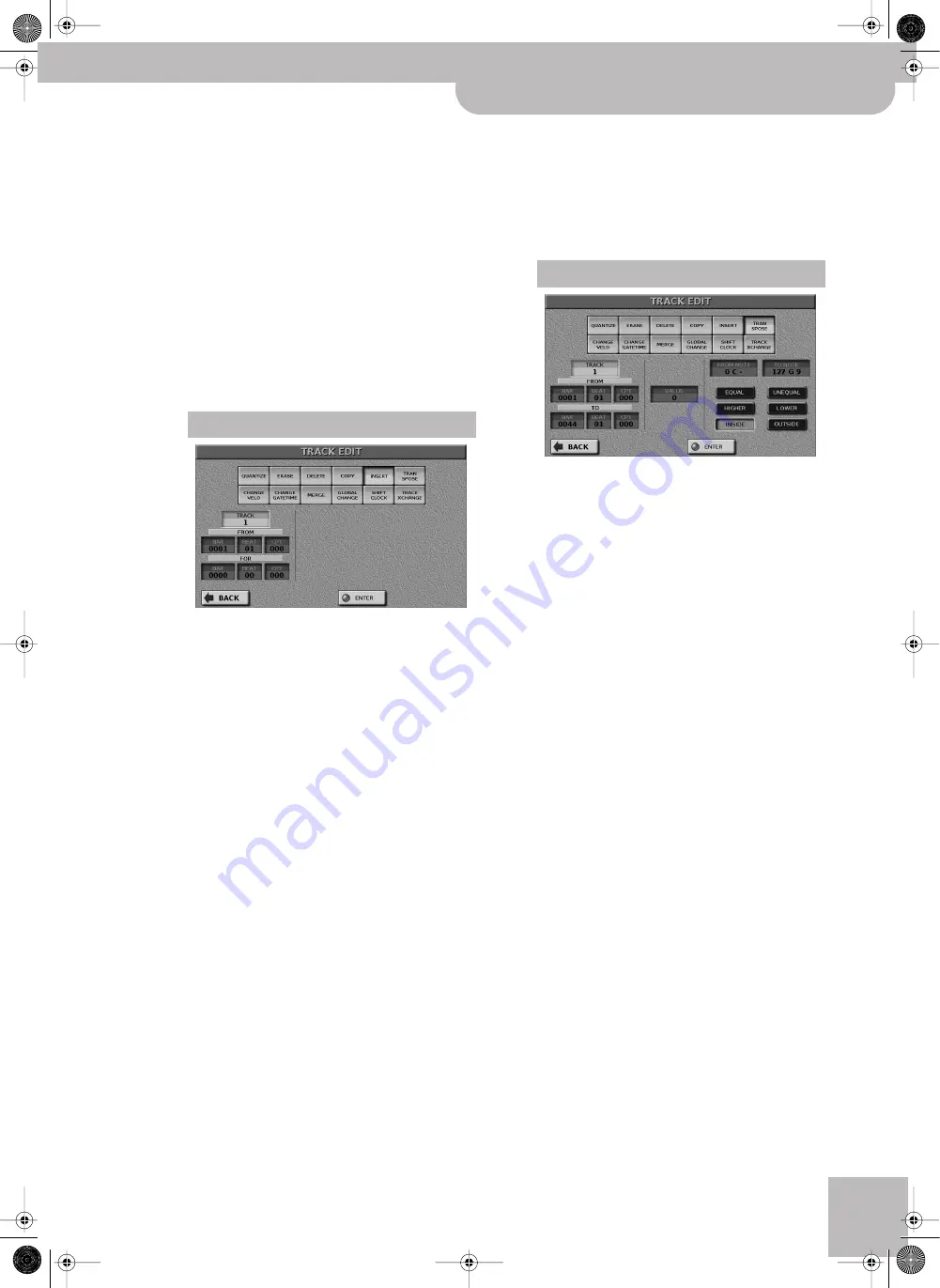
Editing 16-track songs
VIMA JM-8
r
115
■
DST TRACK
This is where you select the track to which you want to
copy the selected data. If you set “SRC TRACK” to “ALL”, the
DST TRACK setting cannot be changed.
■
INTO
Sets the bar, beat and CPT values of the position the first
data of the source track will be copied to.
■
ENTER
Press this display button to confirm your settings and copy
the data.
Note:
Though you can also copy data from track 10 (the
official Drum track) to a “melodic” track and vice versa, this
is only useful if you assign a Drum Set to the selected des-
tination (DST) track. A drum track indeed sounds odd when
played by a piano, for example (and a piano part is not nec-
essarily suited for drumming).
INSERT allows you to insert space and shift data that
lie behind the “FROM” position further towards the
end of the song (this is the exact opposite of
“DELETE”). These empty measures can be “filled” using
the “COPY” function or by recording new phrases in
that area (using PUNCH IN/OUT, for example,
page 128).
Note:
This function provides no “TO” pointer. Instead, you
have to specify the length of the insert using the FOR val-
ues.
■
TRACK (ALL, 1~16)
■
FROM
●
BAR (1~[last measure of the track or song])—
●
BEAT (1~[number of beats per bar])—
beat position. The number of available beats depends on
the time signature in the selected area.
●
Refers to the starting CPT position. “CPT”
■
FOR
Specifies how many bars, beats and CPT units are inserted.
●
BAR, BEAT, CPT—
See above.
■
TIME SIGNATURE
If TRACK= “ALL”, you can use these fields to set the time
signature of the new measures (1~32 & 2, 4, 8, 16).
■
ENTER
Press this display button to confirm your settings and edit
the data.
This function allows you to transpose the notes of
the selected track (non-note data obviously cannot
be transposed).
■
TRACK (ALL, 1~16)
Allows you to select the track you wish to transpose. You
can also select “ALL” here, in which case the operation
applies to all tracks. When used with the
[EQUAL]
option,
“TRANSPOSE” is also useful for drum tracks. It allows you to
select another snare or kick sound, for example. Most Drum
Sets provide at least two snares, one assigned to note num-
ber 38 (D2) and a second assigned to note number 40 (E2).
By entering FROM NOTE= “38”, pressing the
[EQUAL]
dis-
play button and selecting “2”, you can change your D2
snare to the E2 snare.
■
FROM
●
BAR (1~[last measure of the track or song])—
●
BEAT (1~[number of beats per bar])—
beat position. The number of available beats depends on
the time signature in the selected area.
●
Refers to the starting CPT position. “CPT”
■
TO
●
BAR (1~[last measure of the track or song])—
where you specify the bar position of the last measure to
be edited.
●
BEAT (1~[number of beats per bar])—
beat position. The number of available beats depends on
the time signature in the selected area.
●
Refers to the last clock that should be
INSERT
TRANSPOSE
JM-8_OM_GB.book Page 115 Wednesday, July 29, 2009 4:43 PM
Summary of Contents for VIMA JM-8
Page 1: ...r Owner s Manual JM 8_OM_GB book Page 1 Wednesday July 29 2009 4 43 PM ...
Page 174: ...174 rVIMA JM 8 JM 8_OM_GB book Page 174 Wednesday July 29 2009 4 43 PM ...
Page 175: ...For EU Countries For China For China JM 8_OM_GB book Page 175 Wednesday July 29 2009 4 43 PM ...
Page 176: ...R 602 00 0323 01 RES 736 09 JM 8 OM E JM 8 Cov 3 4 GB Page 176 Thursday July 30 2009 10 30 AM ...






























